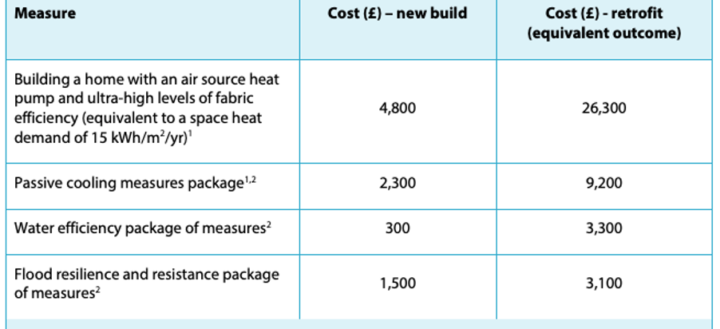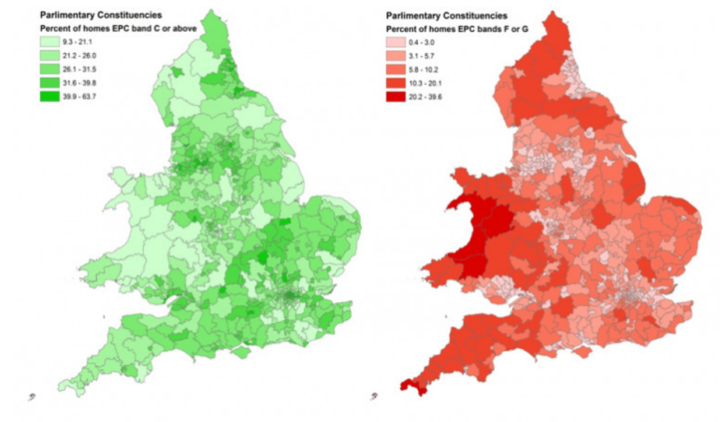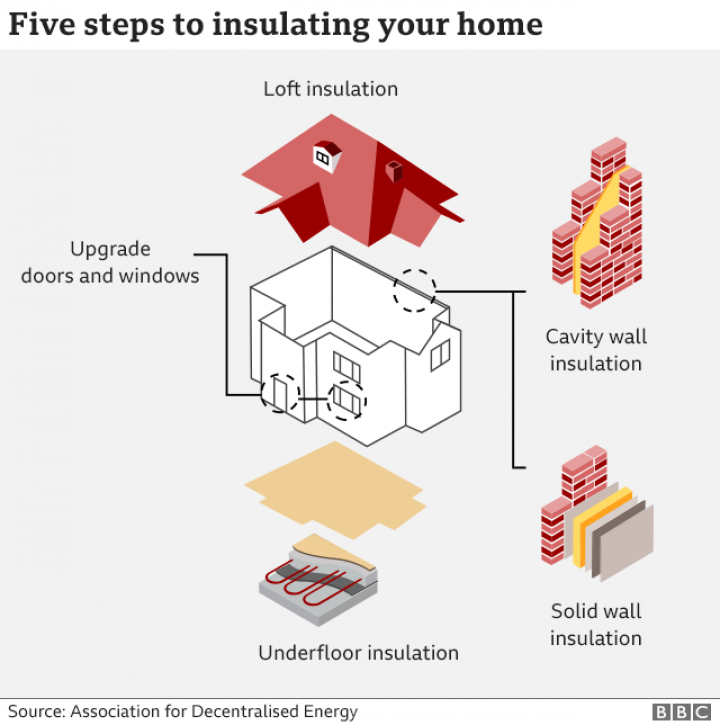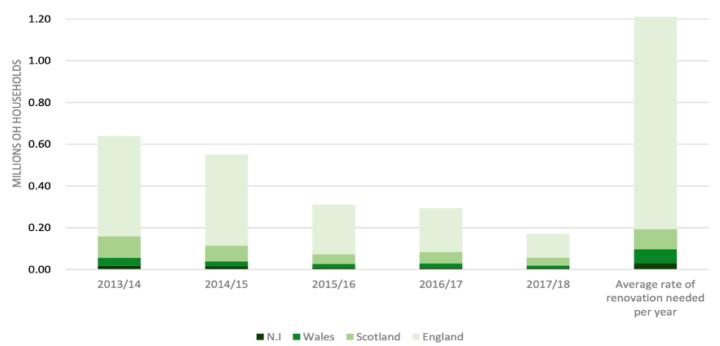Energy efficiency and decarbonising heat
How will properly insulating our homes help decarbonise heating?

By Jess Ralston
@jessralston2Share
Last updated:
Given the UK’s relatively old and inefficient housing stock, with more than one-third of homes built before the Second World War, multiple Governments have targeted energy efficiency to reduce CO2 emissions from buildings.
Energy efficiency in new homes
New homes are widely regarded as ‘low hanging fruit’ for building efficiency. It is much cheaper and easier to build a new home to a high standard of efficiency than it is to upgrade one that has been poorly designed and built.
However in 2019, only 1.4% of new homes built achieved the highest energy performance certificate (EPC) rating, a measure of the property’s energy efficiency. Poor quality homes being built today will likely need to be retrofitted to align with higher standards at a later date, causing additional disruption and cost to consumers.

New homes: regulations and policies
In 2006, the Labour Government announced that all new homes would meet its ‘Zero Carbon’ standard by 2016, followed by setting up the Zero Carbon Hub in 2008, which was designed to help meet this target.
However in 2015, just before the policy was due to come into force, the Zero Carbon standard was scrapped, possibly due to lobbying from major housebuilders. The lack of more ambitious regulations means that since 2007 (when the Zero Carbon standard was announced) nearly two million homes have been built that now need retrofitting, CCC analysis found.
The Government is planning to introduce new standards for new homes. The Future Homes Standard from 2025 has a headline target of cutting emissions by 75-80%, requiring new homes to be better insulated than those built under current building regulations.

However, one of the main issues with new houses is that they might not be built to the same standards that they were designed to, in a phenomenon known as the performance gap. The CCC states that in new builds, “compliance is weak and there is indifference around build quality,” so the opportunity to build low carbon, energy efficient new homes is being missed.
Existing homes: technologies
The vast majority of homes in existence today will still be standing in 2050. The Government will not be able to meet its emissions target without improving the energy performance of the existing building stock. The Government’s current target is to upgrade as many homes as possible to EPC C by 2035.
EPC data shows that the most common rating in new and existing homes across Great Britain is D (on a scale of A-G, with A being the best). Upgrading energy efficiency is a relatively straightforward and cost-effective process. Most heat – up to half – is lost through the walls. Cavity walls can be filled while insulating board can be fixed to solid walls, both internally and externally.
According to the Energy Savings Trust (EST), cavity wall insulation for a typical detached house costs £725, giving an annual saving on energy bills of £255 and saving 1040kgs of CO2 but solid wall insulation likely to be more expensive and varies depending on the home itself.

Research carried out by the EST for the Government found there were 3.6 million uninsulated cavity walls and a further 2.3 million homes with substandard wall insulation. It also found more than 6.6 million homes with inadequate loft insulation. Separate Government figures show that the vast majority of solid wall homes – about 7.5 million – do not have insulated walls.
Experts believe that there is still hope for the Government to reach its (England-only) EPC band C by 2035 targets cost effectively. They estimate that around 17 million insulation measures could be installed in England economically to 2035, which would save billions of pounds in energy bills.
Insulating lofts is even simpler and could cut energy bills by 20%. A typical loft insulation costs £395, giving an annual saving on £225 and saving 620kgs of CO2. Although more expensive and therefore less cost effective, secondary, double or even triple glazing can dramatically cut heat-loss through windows, while draught excluders and foam or rubber strips can be used to seal doors.
Existing homes: regulations and policies
In 2013, the Coalition Government launched the Green Deal to encourage homeowners to invest in energy efficiency and renewable energy. In 2015, the Conservative Government scrapped the Green Deal, through which just 15,000 loans were issued.
Uptake of energy efficiency and insulation measures have stalled, with rates of installation just 5% of the levels they were at in 2012. The Government’s remaining energy efficiency scheme, the Energy Company Obligation (ECO), has been refocussed on those living in fuel poverty since 2018 so the majority of homes (89.7% households are not classed as fuel poor) are not influenced by this.
In 2020 as part of the coronavirus recovery, the Government announced the new Green Homes Grant, which will provide up to £5,000 of grant funding (or up to £10,000 for fuel poor households) for various energy efficiency and some low carbon heating installations. The scheme, however, has struggled with teething problems and in the 2021 Budget funding was cut from £1.5bn to £320m for the 2021/22 financial year.
Poor performance
Homes can perform differently in reality compared to their performance on paper for various reasons, including poor quality installation or the occupant using the home in a different way than is expected. This means it can be difficult to get accurate data on energy use in the home – something that in-situ testing, like the rollout of smart meters, is aiming to address. New technology is also being developed that can measure the true performance of properties, in the hope that this will drive action to reduce emissions.
Costs and savings
Collectively, making homes more energy efficient reduces overall demand for energy, reducing the need for imported fuels, and reducing the amount of clean electricity or low carbon gas needed to power heat pumps and boilers. A number of bodies, including the CCC and the National Infrastructure Committee are, therefore, urging the Government to prioritise energy efficiency.
Some, including a number of business organisations such as the CBI and some major cities, are calling for it to become a national infrastructure priority. One study has shown energy efficiency investments would generate £8.7bn of net benefits, comparable with other infrastructure projects such as Crossrail and HS2. An advantage of investing in energy efficiency is it involves multiple, small, incremental investments that can be adjusted over time, rather than a large, lump sum, all-or-nothing expense

Energy efficiency measures will become even more cost effective when the UK begins to move away from natural gas heating. Options for fuelling the new system that is needed to meet the Government’s net-zero emissions target – electricity and clean hydrogen – are currently more expensive than natural gas, so improving energy efficiency will help to offset some of this additional cost by minimising heat demand in the first place.
For example, one study suggests including insulation measures during the transition to a more electrified energy system could save almost £100 billion by 2050. However, as the cost of renewable energy continues to fall, the cost savings from energy efficiency measures will also fall.
The evidence and recommendations from numerous industry, academic and advisory bodies suggests that energy efficiency is the first essential step to decarbonising homes and heating. To reach net zero, we will need to minimise heat demand and measures to achieve this exist today.